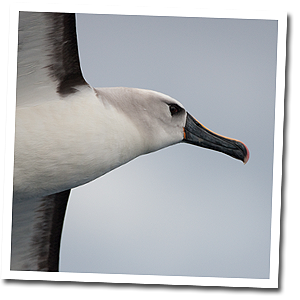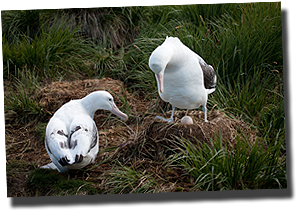












 |
 |
 |
 |
 |
 |
 |
 |
 |
| 1. The exhibition | 2. The birds | 3. Ordering photographs | 4. Feedback | |||||
 |
 |
 |
 |

|
Albatrosses & Storm Petrels: Life At SeaAlbatrosses and storm petrels are perfectly adapted to life at sea. Nearly of them (some 125 species in total) are excellent aerial gliders that use their long, elongated wings to exploit the ocean winds to fly vast distances while minimizing their energy consumption. Except breeding they really do not have a reason to go to land: they eat and sleep at sea, sometimes for years and years. ReproductionAlbatrosses and storm petrels breed on remote islands where predators and humans used to be absent. Many storm petrel species dig a tunnel in the soft soil. At the end of their tunnel, which can be up to 1 to 1.5 metre in lenght, the chick is safe and dry. All albatrosses and some larger petrel species build a nest on the ground. A characteristic of all albatross and storm petrel species is that they produce just one egg per year. Some species of albatross only produce one egg every other year. Both parents take turns on the nest to protect their precious egg or chick. At this rate reproduction of these seabirds is very slow. Fortunately they can grow quite old. Great albatrosses like the Wandering and Royal Albatrosses probably reach sixty years of age or more. DietAlbatrosses and storm petrels feed at sea. They are mainly scavengers that are not too picky: crustaceans or other plankton, fish and squid are on the menu. They can fast for impressive lengths of time. But if there is food to be found, they do not hestitate and go for it! From all around the birds gather whenever there is an opportunity. Part of their meal is stored as a fat reserve, while in the breeding season food is stored in a special pre-stomach where it is converted into an oily and nutrient-rich pasta which is then fed to the chick.Threats (and solutions)Even though albatrosses and storm petrels breed far away from humans, we are still the ones that are the biggest threat to these birds. Natural disasters such as fires, volcanic eruptions or floodings (heavy rainfall or tsunamis) can cause many casualties too, but are rather infrequent and are currently not considered to impact seabird populations on the long term. However human influence is much more direct: today many species of seabird are vulnerable and threatened with extinction. There are various ways in which humans impact on the life of these birds, and every problem as its own solution. Sometimes solutions are very simple, and you can act too - straight away: |
| Threats | Solutions |
| 1. Fishing Industry
The industrial scale of today's fisheries causes many fatalities amongst seabirds every year. Birdlife estimates that 100.000 albatrosses plus another 200.000 storm petrels die each year from the fishery industry.
|
The global fisheries organisations quickly have to take measures to reduce the 'accidental bycatch' of seabirds (and other marine species):
|
| 2. Loss of habitat
Over grazing by introduced rabbits and sheep causes the soil to erode. As a result storm petrels cannot dig tunnels (nest) anymore. |
|
| 3. Predation by non-native animals
Mice, feral cats and rats have often been introduced accidentally on the islands by ships. These animals predate on seabird eggs and chicks, and sometimes also on adult birds. |
During the last couple of years many non-native animals have been eradicated from seabird islands, allowing these birds to recover their populations. |
| 4. Marine debris
Plastics and other litter at sea mainly threatens seabirds in the northern hemisphere. Seabirds are used to eating anything that floats on the surface. The litter enters their stomach maag, which leaves little space for food, reducing their fitness. Plastics at sea are gradually broken down to very small particles until they are eaten by plankton of fish, from where it enters the marine food network. | It is crucial that our litter does not enter the rivers which will sooner or later transport it to the open sea.
|
5. Increasing sea water temperatures
|
Changing the Earth's climate may be something we do something about. Or maybe nothing, or a lot? It is a complex issue with no direct solutions.
However, indifference is not an option. Check what you can do for yourself. Many websites offer practical tips to reduce your ecological impact. |
 |
What can YOU do?
|